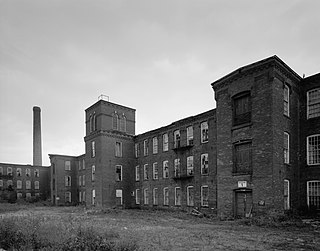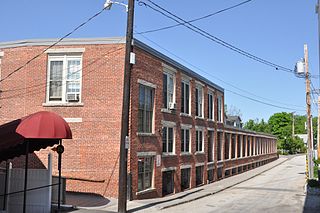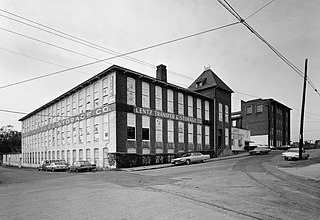
King Philip Mills is an historic cotton mill complex located at 372 Kilburn Street in Fall River, Massachusetts. Developed between 1871 and 1892, it was historically one of the city's largest mills, and its building inventory is still largely complete. The complex was added to the National Register of Historic Places in 1983.

The Renfrew Mill No. 2 was a historic mill complex at 217 Columbia Street in Adams, Massachusetts. Most of its buildings were built between 1867 and 1878, and were brick buildings with Italianate styling. They were built by the Renfrew Manufacturing Company, a textile manufacturer, to replace an earlier complex further down Columbia Street that had been demolished. The property was acquired by the Arnold Print Works in 1928. The mill was the town's largest employer for much of the second half of the 19th century.

Londontown Manufacturing Company, Inc., also known earlier as the Meadow Mill of the old Woodberry Manufacturing Company is a historic cotton mill industrial complex located at Baltimore, Maryland, United States. It is a four-story, Italianate red brick structure that features a square tower structure with a truncated spire-like roof having an open bell tower cupola. It sits on the west bank of the Jones Falls stream which runs north to south, parallel to the elevated Jones Falls Expressway.

The Hamilton Woolen Company Historic District encompasses the well preserved "Big Mill" complex of the Hamilton Woolen Company, built in the mid 19th century. Located at the confluence of McKinstry Brook and the Quinebaug River in central Southbridge, Massachusetts, the complex consists of a cluster of mill buildings and a rare collection of 1830s brick mill worker housing units located nearby. The district was listed on the National Register of Historic Places in 1989.

Market Square is a furniture showroom complex in High Point, North Carolina, owned by International Market Centers which is the largest building in North Carolina on the National Register of Historic Places (NRHP), and the sixth largest in the United States. Known also as Tomlinson Chair Manufacturing Company Complex, it was listed on the NRHP under that name. The former manufacturing complex includes the oldest factory building in the city, and its renovation has been credited with making High Point a successful furniture exhibition center. A 16-story addition in 1990 is one of the city's tallest buildings.

The Page Belting Company Mills is a historic mechanical belt mill complex at 26 Commercial Street in Concord, New Hampshire, United States. Located north of Concord's central business district near Horseshoe Pond, the complex consists of four brick buildings built between 1892 and 1906 for one of the city's major businesses. The mill complex, now converted to residential and other uses, was listed on the National Register of Historic Places in 2002.

Erwin Mill was a textile mill in Durham, North Carolina that operated between the years of 1893 and 1986. After seeing the success of other cotton mills in the Northeast and locally in Durham, entrepreneur Benjamin N. Duke incorporated the mill in 1892 and recruited William H. Erwin to manage the enterprise. The mill's success in the late 19th and early 20th centuries was the result of Erwin's and his successors' exceptional management tactics, even when the factory hit obstacles such as the Great Depression and the unionization of its workers. The mill grew quickly in the late 19th century and early 20th century, became one of North Carolina's largest cotton mills. It originally produced muslin pouches for tobacco, but the mill would later expand its production to other fabrics, becoming one of the largest producers of denim in the world during the early 1900s. Workers at the mill enjoyed some of the best working conditions and highest wages in textile factories throughout the southern United States. Mill employees would later sign union-friendly labor agreements that were radical to the southern textile industry in the early to mid 20th century. The establishment of homes, businesses and recreation areas in the mill village was a significant factor in the development of the West Durham, especially the Ninth Street business district and the Old West Durham Neighborhood. Erwin Mill No. 1 is on the National Register of Historic Places and the mill village of West Durham is a National Historic District. An apartment complex, office building and shopping center of the same name that are built on the original site also commemorate the factory.

The Milford Cotton and Woolen Manufacturing Company is a historic mill complex at 2 Bridge Street in the center of Milford, New Hampshire. Developed between 1813 and World War I, it is one of the few surviving mill complexes in Milford, whose name is derived in part from "mill". The buildings were listed on the National Register of Historic Places in 1982. The complex has been converted into residential use.

The Cocheco Mills comprise a historic mill complex in the heart of Dover, New Hampshire. The mills occupy a bend in the Cochecho River that has been site of cotton textile manufacturing since at least 1823, when the Dover Manufacturing Company supplanted earlier sawmills and gristmills. The present mill buildings were built between the 1880s and the early 20th century, and were listed on the National Register of Historic Places in 2014.
Dunavant Cotton Manufacturing Company, also known as Alpine Cotton Mill No. 1, is a historic cotton mill located at Morganton, Burke County, North Carolina. It is a two-story, brick-clad, side gable-roofed building. The original section was built in 1888–1910, with additions and expansions through 1966. The additions to the building, made in the mid to late 1960s were removed in 2012 to reveal the original 1888-1910 mill building. It is the oldest cotton textile mill in Morganton, and was in use as a cotton textile mill until 1949.

Hudson Cotton Manufacturing Company, also known as Shuford Mills, is a historic textile mill located at Hudson, Caldwell County, North Carolina. It was built in stages between 1904 and 1992, and is a large, one-story, brick building of nearly 180,000 square feet. It features a three-stage, square, brick tower built as part of the original, 1904, construction.

Durham Cotton Mills Village Historic District are a set of historic mill village houses and national historic district located at Durham, Durham County, North Carolina. The district encompasses 15 contributing residential buildings built by the Durham Cotton Manufacturing Company. They are 1+1⁄2-story, "story and a jump" gable end frame dwellings dated to the mid-1880s. Twelve of the dwellings have rear one-story, gable-roofed ells.

Durham Hosiery Mill is a historic textile mill complex located at Durham, Durham County, North Carolina. It includes seven contributing brick buildings in the complex. The original Durham Hosiery Mill was built in 1902, and consists of a four-story main building with a six-story Romanesque Revival-style tower in front; engine, boiler, and heater houses attached at the rear, and a one-story dye house. The main building was expanded with a two-story annex in 1904, and a three-story annex in 1906. Other buildings include the triangular Annex No. 1 (1912) and a three-story brick finishing building. By 1910, the Durham Hosiery Mills Corporation was the largest manufacturer of cotton hosiery in the world. The mill was abandoned in 1922.

West Durham Historic District is a national historic district located at Durham, Durham County, North Carolina. The district encompasses 101 contributing buildings in a mixed industrial, commercial, and residential section of Durham. The buildings primarily date after 1892 and include notable examples of Classical Revival, Italianate, and Queen Anne architecture. Located in the district is the separately listed Erwin Cotton Mills Company Mill No. 1 Headquarters Building. Other notable buildings include Erwin Cotton Mills Co. Mill No. 4 (1909–10), Erwin Cotton Mills Co. worker's housing (1910s), Fidelity Bank (1920s), E. K. Powe School (1928), Blacknall Memorial Presbyterian Church (1923), and St. Joseph's Episcopal Church.

Arista Cotton Mill Complex, also known as Salem Cotton Manufacturing Company and Arista Cotton Mill and Lentz Transfer & Storage Co., is a historic cotton mill complex located at Winston-Salem, Forsyth County, North Carolina. The complex includes two buildings: a brick building built in 1836 by part of the Moravian congregation of Salem and the original home of the Salem Cotton Manufacturing Company, and the other is the original Arista Mill, built in 1880 by F. and H. Fries Cotton Arista Mills. The 1836 Salem Cotton Mill is a three-story, brick building with a monitor roof. The 1880 mill is a three-story brick building, 14 bays long, with bracketed eaves with timber supports. A two-story roughly triangular brick building was added about 1900. The 1836 building has been converted to a hotel known as The Historic Brookstown Inn.

Oakdale Cotton Mill Village is a historic textile mill, mill village, and national historic district located at Jamestown, Guilford County, North Carolina, United States. The district encompasses 37 contributing buildings including the Logan Manufacturing Company complex built during the 1880s and 33 frame mill worker houses dated to the early-20th century. The factory complex consists of a three-story rectangular brick office, a one and two-story L-shaped brick factory with a four-story tower and five one-story brick warehouses, a small one-story board-and-batten blacksmith shop, and a polygonal brick smokestack.

Revolution Cotton Mills, also known as Revolution Division and Cone Mills, is a historic cotton mill complex located at Greensboro, Guilford County, North Carolina. The complex was built between 1900 and the mid-20th century and is an example of "slow burning construction." It includes 12 contributing buildings and 2 contributing structures. They include the main mill building, warehouses, weave room and machine shop, bleachery and dye room, storage/shipping/office building, and yellow brick chimney stack. The mill ceased operation in February 1982. As of 2024, the 45-acre complex includes 800,000 square feet of space with office, residential and retail development and event space. 140 businesses and nonprofits have located in the building, and 20 percent of its 184 apartments are considered affordable.

Borden Manufacturing Company, also known as Goldsboro Cotton Mills and Wayne Cotton Mills, is a historic factory complex located at Goldsboro, Wayne County, North Carolina. The complex includes the Goldsboro Cotton Mills (1892), Goldsboro Smokestack (1905), Goldsboro Boiler Room, Borden-Goldsboro Pedestrian Bridge, Borden Manufacturing Company (1900), Borden Water Tank, Borden Auto Garage, Borden Reservoir, Borden Reservoir Pump House, Borden Railroad Siding Tracks, Borden Conditioning Room, and Borden Storage Building. The Goldsboro Cotton Mills is a two-story, 16 bays long, gable-front, brick building with Italianate style detailing. It features a central three-story square tower, three bays in width.

The Coleman-Franklin-Cannon Mill is a historic industrial complex at 625 Main Street SW in Concord, North Carolina. The recognized complex consists of ten buildings on 6.6 acres (2.7 ha), about 2 miles (3.2 km) west of downtown Concord. Another 4.4 acres are not included. The oldest portion of the mill, now its eastern section, is a brick two-story structure 14 bays long and 9 deep. The historic site also includes some worker housing.

The Moore and Thompson Paper Mill Complex is a major late 19th-century industrial site off Bridge Street in Bellows Falls, Vermont. It is the largest surviving mill complex from the village's industrial heyday, and is one of the largest of the period in the state. It was listed on the National Register of Historic Places in 1984.























